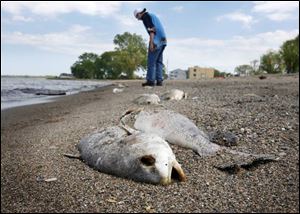
Big fish kill leaves experts puzzled, landowners gasping
5/6/2006
Chris Smith, 18, of Port Clinton examines some of the dead fish littering the Lake Erie shoreline at the city's beach. The deaths of thousands of fish are puzzling wildlife experts.
Thousands of carcasses of freshwater drum are piling up along the shores of Lake Erie, leaving wildlife experts puzzled as to the cause and lakefront property owners holding their noses.
The fish, also known as sheephead, are unpopular with anglers. But their deaths in the last several weeks have created a mystery for fish biologists.
Jeff Tyson, fisheries biology supervisor with Ohio's Sandusky Fish Research Unit, said yesterday the state has fielded at least 300 telephone calls in the last week alone about the fish kill.
Biologists have ruled out a thermal inversion, or fluctuation in the water's temperature, low levels of dissolved oxygen, and toxic blue-green algae.
The kill has not affected Lake Erie's popular game fish, such as walleye and perch.
"We don't see this affecting sport fishing," Mr. Tyson said.
The lake traditionally experiences fish kills each spring, he said, but the number of fish washing ashore is exceptionally large.
"This is more extensive than our typical winter kill," he said.
Property owners between Toledo and Vermilion are left with the smelly task of cleaning up the beaches, or leaving the carcasses to the gulls and waves.
"It's pretty smelly," said Rachael Lucas, manager of Castaway Harbor marina on East Bayshore Road near Marblehead.
In Sandusky, Tom Slattery is taking the kill in stride by burying the dead fish on the beach in front of his home on the Cedar Point Chaussee.
"From what I saw, our strip seems to have quite a few," he said.
"I'd say 99 percent of them are sheephead, a half-dozen white bass, and one perch."
Mr. Slattery said he was burying the fish on the beach, where the sand and wave action will grind down the bodies without leaving a stench.
"They smell. You've got to bury them so it gets ground up in the surf," he said.
Fish kills in the spring generally are attributed to fluctuations in water temperatures. This past winter was not a particularly cold one. But that in itself may have contributed to the increase of bacteria, which survived an extensive freeze, Mr. Tyson said.
Samples of the fish have been sent to U.S. Fish and Wildlife laboratories for analysis, but Mr. Tyson said the results are not expected for at least 30 to 60 days. The time frame is dictated by the need to grow cultures to determine if a bacteria or pathogen is involved.
For fish-eating birds that hover around the shoreline, the fish kill has been a feeding bonanza.
"The seagulls look pretty fat," Mr. Tyson said.
A woman who lives on the Marblehead peninsula fears the fish may be a health hazard for children this summer.
Wilma Hastings said she has contacted the Ohio Environmental Protection Agency and spoken with state wildlife officials about the problem.
"If the fish are toxic, we don't want to touch them to clean them up," she said, describing a putrid beach-walking experience earlier in the day. "It stinks. The smell is horrendous."
The large, smelly carcasses have created extra work for marinas and others whose livelihood depends on the lake.
"We do a cleanup every day," Ms. Lucas said.
Her marina noticed the problem about a month ago and has collected between 500 and 700 dead sheephea, which were buried on a 30-acre plot away from the harbor.
"We keep up with it. We have no choice," she said.
"Actually, I let the guys do it. I can't handle it."
Contact Jim Sielicki at:
jsielicki@theblade.com
or 419-724-6078.